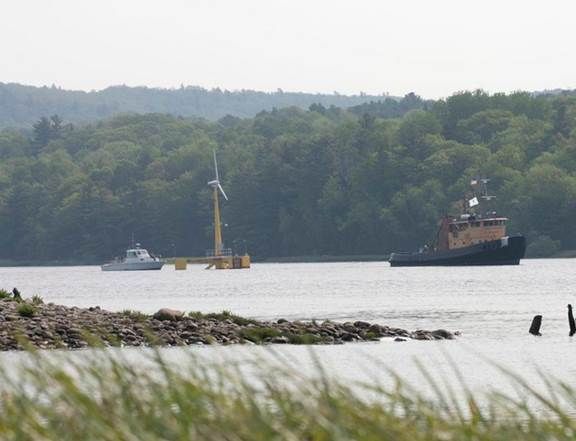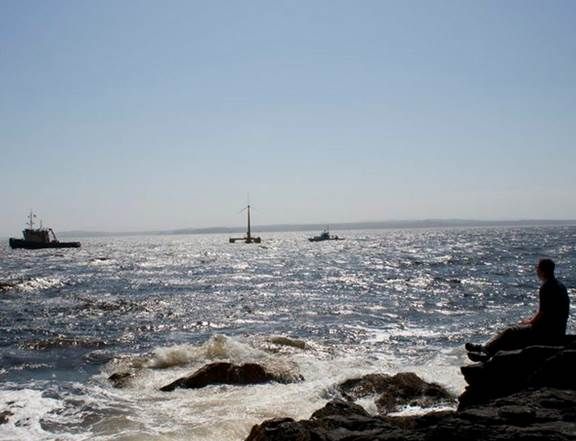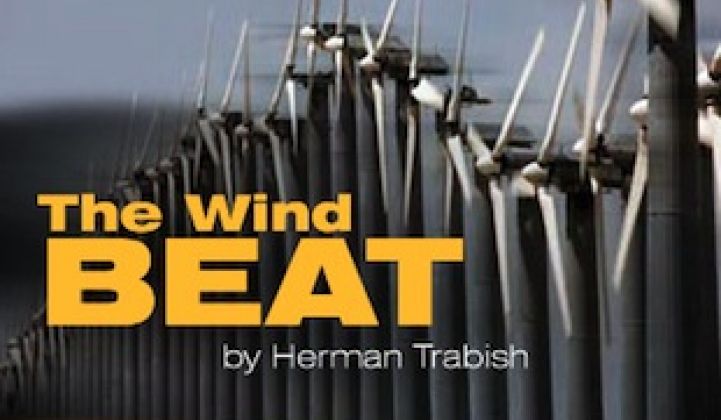The first floating wind turbine in U.S. waters was towed into the Atlantic over the weekend, and it might be a big new greentech investment opportunity.
At its first destination in 200-foot-deep water, 100 feet off of a Maine beach, VolturnUS 1:8, a one-eighth-scale prototype built by the University of Maine’s Advanced Structures and Composites Center, became the first grid-connected offshore turbine in U.S. waters. There, its engineers and designers will validate computer models for the next month.
At the end of June, VolturnUS will be towed to 400-foot-deep waters twelve miles off Maine’s coast. There, engineers and designers will study the challenges they face in building two full-scale, six-megawatt units for launching into deep ocean waters in 2016 and 2017.

These offshore wind milepost events came just ahead of the Department of Interior (DOI) Bureau of Ocean Energy Management (BOEM) announcement that it will auction two pre-designated areas in federal waters off Rhode Island and Massachusetts July 31 to a list of pre-qualified developers.
The North Lease Area could produce up to 1,955 megawatts of installed wind capacity and the South Lease Area could produce 1,440 megawatts, according to a National Renewable Energy Lab report.
A BOEM Environmental Assessment has already produced a Finding of No Significant Impact (FONSI) for the two areas and determined nine developers to be “legally, technically and financially qualified” to bid, according to Director Tommy Beaudreau.
BOEM’s pre-planning for the Smart from the Start program will significantly cut the cost and time for development by the winners of the auction, which will be selected from among:
- Deepwater Wind New England, LLC
- EDF Renewable Development, Inc.
- Energy Management, Inc.
- Fishermen’s Energy, LLC
- IBERDROLA RENEWABLES, Inc.
- Neptune Wind, LLC
- Sea Breeze Energy, LLC
- U.S. Mainstream Renewable Power (Offshore) Inc.
- U.S. Wind Inc.
“The competitive lease sale is a vital step forward for the offshore wind industry,” said Offshore Wind Development Coalition Spokesperson Jim Lanard.

Maine’s program, the culmination of a public-private R&D program with DOE, the National Science Foundation, the Maine Technology Institute, the state of Maine, and 30-plus industry partners, is about to go commercial.
“The larger goal is to make offshore wind cost-competitive with other energy producers,” explained Elizabeth Viselli, Offshore Wind Programs and Communications Manager, as well as to “get the cost to $0.108 per kilowatt-hour by 2020.”
The program’s origins in advanced composite materials will make that possible, according to Viselli. Its concrete floating platform, the first in the world for offshore wind, makes it less expensive and more easily built near load centers than other turbine technologies that require imported and price-volatile steel, she said.
Its lightweight, durable, advanced composite tower eliminates weight, cost, and manufacturing infrastructure associated with steel, Viselli added. “We can go pretty much anywhere without capital investment in port facilities.”
The University is seeking investors in Aqua Ventus LLC, a spinoff that will operate as a holding company for pilot and commercial projects designed and developed worldwide for the VolturnUS technology, Viselli said.
“There are two investment opportunities on the table,” she explained. “The first is for investors in Aqua Ventus LLC, the patent-holder for the Aqua Ventus technology and synergistic technologies. The other is for traditional equity and tax equity investors for the 12-megawatt, 2016-2017 demonstration project and the follow-on gigawatt project in Maine.”

VolturnUS was one of seven offshore projects to get startup costs funded by the U.S. Department of Energy (DOE) multi-year $180 million Advanced Technology Demonstration Projects Initiative. Three finalists will be selected in 2014 for significantly more backing.
Among the seven were the world’s two other floating turbine projects being developed by Statoil Hywind and Principle Power. Both have generating 2-megawatt turbines floating in Europe.
Statoil plans to build four Siemens 3-megawatt Hywind turbines on floating spar buoy structures in the Gulf of Maine. Principle Power intends to build five 6-megawatt direct-drive offshore WindFloat turbines on semi-submersible floating foundations in deep water ten miles to fifteen miles off Coos Bay, Oregon.
“Principle Power was the first U.S. company to deploy a floating wind turbine when it put a 2-megawatt floating Vestas turbine into 45-meter waters five kilometers off Portugal’s coast,” CEO Alla Weinstein said. “When Statoil launched its pilot project in Norway in 2009, people saw it as speculative. When we installed our turbine in 2011, it changed the whole paradigm.”
Weinstein said she welcomes all newcomers to offshore wind. “It is a new industry,” she said. “One or two companies is not an industry. It is always good to have competition.”
Two years ago, people were wondering when floating offshore wind would happen and what its future would be, Weinstein said. “Now they want to know how fast we can get there. And I tell them, ‘Invest the money to shrink the time.’”
That’s what is important about BOEM’s streamlined permitting and leasing policies, Weinstein added. They shrink the time -- and that shrinks the costs.



